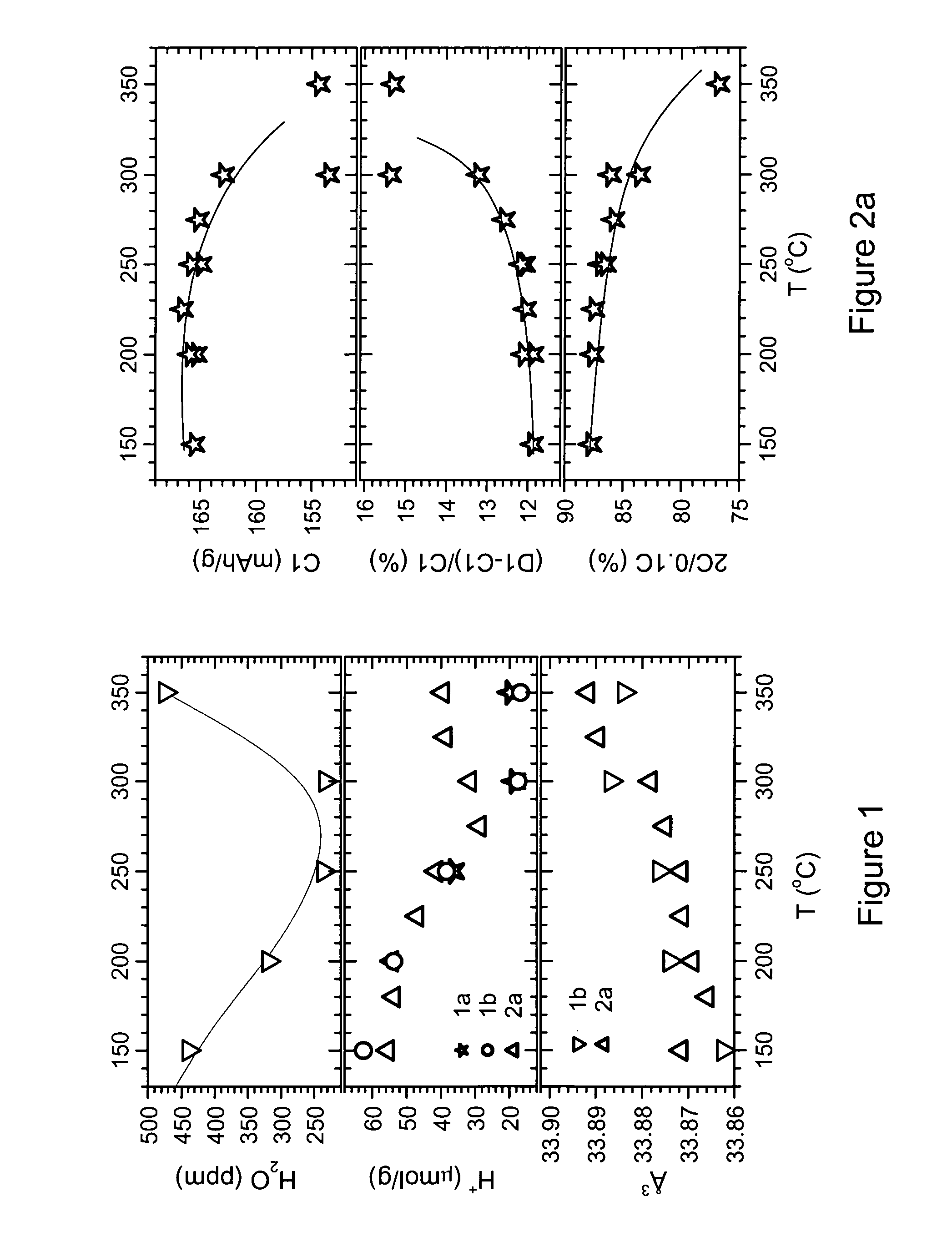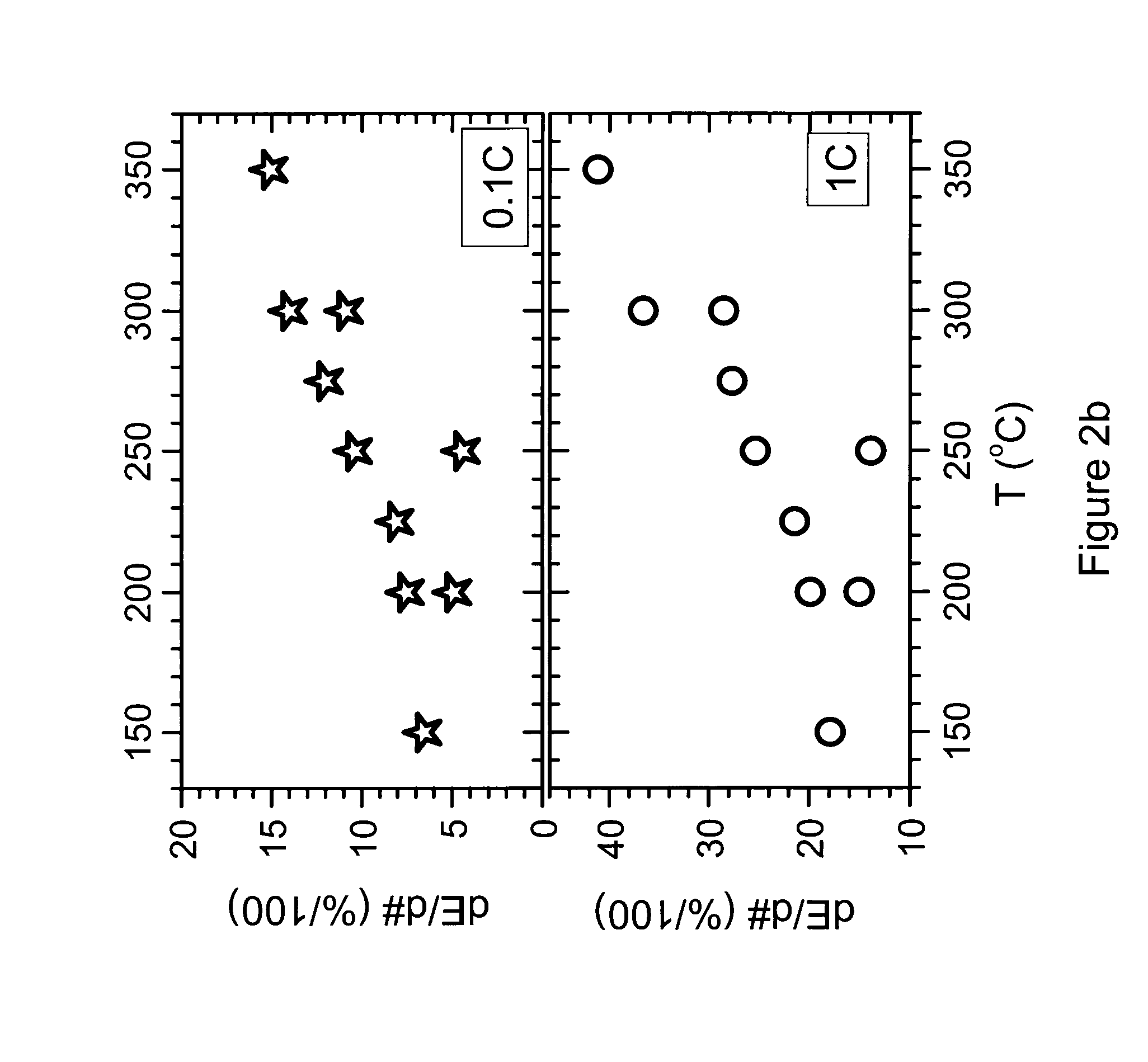Double-Shell Core Lithium Nickel Manganese Cobalt Oxides
a cobalt oxide and nickel manganese technology, applied in the field of lithium nickel manganese cobalt oxides, can solve the problems of increasing the cost of this material, different limitations or challenges, and difficult preparation
- Summary
- Abstract
- Description
- Claims
- Application Information
AI Technical Summary
Benefits of technology
Problems solved by technology
Method used
Image
Examples
example 1
[0074]This example demonstrates the effects of a coating with a fluorine containing polymer followed by a temperature treatment:[0075]1) A reaction between cathode and polymer happening at higher temperature, and[0076]2) Formation of a LiF protective film
[0077]Also, the example investigates the influence of the temperature on samples coated by polymer having a LiF interface. This example shows results for samples prepared by adding 1% polymer. A LNMO mass production sample is used as cathode precursor (precursor=uncoated or bare sample). The composition is Li1+xM1−xO2 with M=Ni0.5M Mn0.3Co0.2 and x about 0.00. The precursor further contains 0.145 mol % 5 and 142 ppm Ca.
[0078]100 g of cathode precursor and 10 g of PVDF powder are carefully premixed using a coffee grinder. Then the 110 g of intermediate mixture is mixed with 900 g remaining cathode precursor, at medium energy using a Haensel type mixer. The precursor-PVDF mixture is sampled to batches of 100 g each. These batches are ...
example 2
[0106]Example 1 investigated a coating by 1% PVDF. However, at treatment temperatures T>275° C., and especially >300° C., it is observed that the decomposing polymer extracts so much Li from the cathode, causing a decrease of the reversible capacity. This indicates that the resulting LiF film might become unnecessarily thick. Therefore the present example illustrates the invention for a heat treatment using less polymer, only 0.3 wt % PVDF. As before, the example investigates the influence of temperature on the preparation of samples coated by polymer having an LiF interface. An LNMO mass production sample is used as cathode precursor. Its composition is Li1+xM1-xO2 with M=Ni0.5Mn0.3Co0.2 and x about 0.00. The precursor further contains 0.145 mol % 5 and 142 ppm Ca.
[0107]100 g of cathode precursor and 3 g of PVDF powder are carefully premixed using a coffee grinder. Then the 103 g of mixture is mixed with the remaining 900 g cathode precursor, and mixed at medium energy using a Haen...
example 3
[0110]This example investigates the influence of temperature on the preparation of LiCoO2 samples coated by polymer having a LW interface. The example discusses the voltage profile and microstructure of a suitable LiCoO2 to give further evidence for the conclusions of examples 1-2. The key conclusions are similar to examples 1-2: between 200-350° C. a LiF film forms. The thickness increases with temperature. Otherwise, a LiF film cannot be retained at higher temperature.
[0111]The example shows results for samples prepared by adding 1% PVDF polymer. A lithium cobalt oxide mass production sample is used as cathode precursor. Its composition is 1 mol % Mg doped LiCoO2, having a mean particles size of 17 μm. 1000 g of this precursor powder and 10 g of PVDF powder are carefully mixed using a Hensel type mixer. The mixture is sampled to batches of 150 g each. These batches are heat treated for 9 h at temperatures ranging from 150-600° C. The resulting powder is sieved. The powders are ana...
PUM
| Property | Measurement | Unit |
|---|---|---|
| particle size | aaaaa | aaaaa |
| thickness | aaaaa | aaaaa |
| thickness | aaaaa | aaaaa |
Abstract
Description
Claims
Application Information
 Login to View More
Login to View More - R&D
- Intellectual Property
- Life Sciences
- Materials
- Tech Scout
- Unparalleled Data Quality
- Higher Quality Content
- 60% Fewer Hallucinations
Browse by: Latest US Patents, China's latest patents, Technical Efficacy Thesaurus, Application Domain, Technology Topic, Popular Technical Reports.
© 2025 PatSnap. All rights reserved.Legal|Privacy policy|Modern Slavery Act Transparency Statement|Sitemap|About US| Contact US: help@patsnap.com



